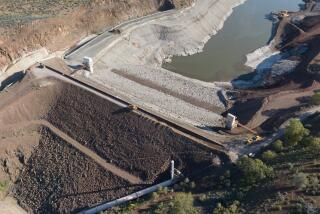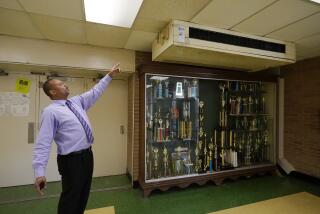Uphill Battle : Bureaucracy Bogs Down Effort to Move Threatened Castaic School to Higher Ground
- Share via
CASTAIC — It was the light fixtures that turned off the Castaic school district trustees.
Since September of 1994, they have been trying to secure millions of dollars in federal earthquake-mitigation funds to move the 638-student Castaic Elementary School, which sits in the shadow of the dam that holds back half-mile-long Castaic Lake, and is bordered by high-voltage power lines and oil pipelines to boot.
The paperwork pace has been maddeningly slow, board members say.
But what really annoyed them was that it took only one week, from Nov. 27 to Dec. 5, for 63 other school districts--including the Los Angeles Unified School District--to receive approval of $106 million in grants to strengthen light fixtures against damage in future quakes.
“We learned light bulbs were more important than moving . . . kids out of imminent danger,” said trustee Lester Freeman. “They’re stalling us forever.”
But federal officials counter that moving a school is not as simple as replacing a light bulb.
In the government’s defense, Jay Jazayeri of the Federal Emergency Management Agency counters, “We did not put the dam above the school.”
The dam just 1.7 miles behind the school holds back 323,000 acre-feet of water--equivalent to half of the city of Los Angeles’ water needs for one year.
The current school, which shares the land with the district administrative offices, has been there since 1928, but there have been schools on the site since the late 1880s. Local records indicate that four ranches and a pig farm were flooded when the dam was completed in 1972. But at the time, the school was very small and was overlooked, said James Estes, director of business for the district.
Bonds to build the dam were approved in the early 1960s, an era before environmental studies and local community activism might have prompted more reflection on its impact on the school. “They got by with things they would never get by with today,” said Betty Hanson, a consultant assisting Castaic as it moves through the FEMA process.
Yet as the school-age population has grown in the booming Castaic area, officials have grown concerned not only about the dam, but also about the high-voltage power lines and oil pipelines that cross the school grounds, running near play areas.
“It’s like the triad of terror that awaits these kids,” Estes said.
Added Freeman: “Even Saddam Hussein wouldn’t put a school there.”
Experts believe it would take only three minutes for the campus to be flooded by 150 feet of water if Castaic Dam ruptured during an earthquake.
But they agree that such a catastrophe is unlikely--the worst-case scenario in a worst-case quake of 8.2. State officials familiar with the 335-foot-tall dam say it is built to withstand a major temblor. They point out its trapezoidal wall has a mighty base 2,000 feet thick. They say that not a drop of water has ever seeped from the structure.
Castaic voters approved $20 million in bond issues in 1993 to move the 532-student Castaic Middle School out of the flood plain to a nearby site, and although that school is still on the site, the move to a new school on higher ground three miles away is expected to be completed by next September.
Freeman said trustees expected the state to chip in additional funds to move their elementary school as well. However, when state funds dried up after voters turned down school-construction bonds, the project had to be postponed.
Then, the Northridge earthquake jolted faith in monuments of engineering. School officials petitioned to obtain FEMA money targeted for earthquake-hazard mitigation, to move the elementary school to a site beside the new middle school in Hillcrest Park.
At first, federal officials reacted positively--moving forward on an application to approve $18 million in federal money to relocate both the schools and the adjacent district offices.
Using the bond money, school officials started work on the new middle school, in anticipation of receiving the federal money.
But by summer, FEMA informed Castaic officials that a change in federal policy required an environmental impact review be completed before work could commence.
Because construction work had already begun before the report was completed, the district lost its eligibility for $10 million earmarked for the middle school. It had to submit a new application for $7 million to move the elementary school and for the district offices.
The Castaic proposal was submitted to FEMA on Friday. Federal officials promise an answer in 45 days--although the on-again, off-again nature of federal work days because of the budget crisis could drag out the process.
“We were trying to do a project to put them out of harm’s way,” FEMA’s Jazayeri insists.
District officials, meanwhile, are watching anxiously after supplying information to answer a stream of inquiries from the state Office of Emergency Services, which processed the application to FEMA.
“We think we have [given them] all the information,” Estes said. “But we’ve thought that before.”
“They keep changing the rules,” Freeman said. “If they wouldn’t have gotten nit-picky, they would have these kids off the site.”
More to Read
Sign up for Essential California
The most important California stories and recommendations in your inbox every morning.
You may occasionally receive promotional content from the Los Angeles Times.













